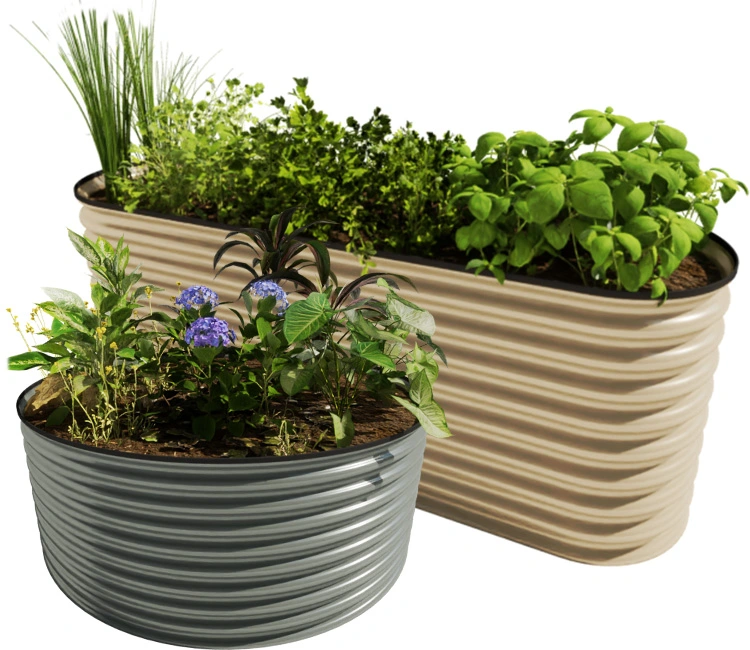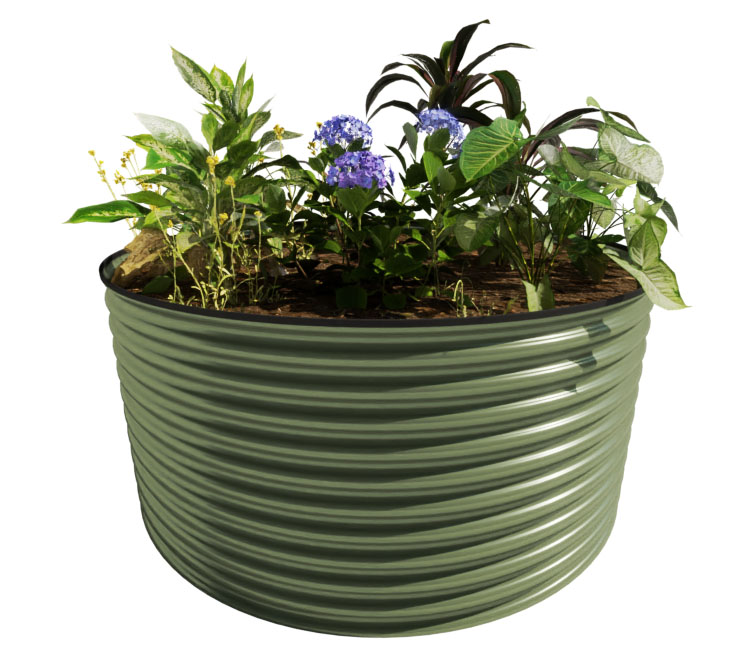Colorbond / AQUAPLATE® Raised Garden Beds
Raised steel garden beds are a lightweight, ready-made option for any space. Easily placed in gardens, on lawns, concrete slabs (with a base), or tank stands, they are ready to use immediately.
Why Choose Our Raised Garden Beds?
No assembly required – ready-made for your convenience. Built to last with structural integrity and Colorbond / AQUAPLATE® material. Low maintenance and long-lasting. Customisable shapes and sizes available.
Slimline or Round: Tailored to Your Space
Our raised garden beds are typically slimline in shape, perfect for limited spaces, or round for a unique garden feature. Custom designs are available to complement your existing structures or meet specific mobility needs.
Easy Access, Good Drainage
Enjoy hassle-free gardening with our raised garden beds. Designed for easy access without bending or kneeling, they offer good drainage and can be placed on various surfaces. Perfect for pet owners looking to keep their furry friends out of the garden.


Environmental-Friendly Solutions: Colorbond Raised Garden Beds
Our Colorbond / AQUAPLATE® raised garden beds will minimise your environmental footprint. Made from recyclable materials, these beds offer a sustainable gardening solution while adding a pop of color to your outdoor space. Get more information and options about our Colorbond® finishes
Buy Raised Garden Beds Today
Transform your garden with our range of raised garden beds. With options to suit every budget and preference, finding the perfect bed for your garden has never been easier. Explore our selection and elevate your gardening experience with Select Water Tanks.
Raised Garden Beds Example Sizes & Types
Browse our collection of raised garden beds to find the perfect fit for your garden. With a range of Colorbond / AQUAPLATE® options, we have everything you need to enhance your gardening experience. Our raised garden beds are available in customisable heights from 600mm to 800mm, widths from 600mm to 1150mm, and lengths from 1200mm to 3000mm. At Select Water Tanks, we’re not limited by these dimensions.
- All
- Round Tanks
- Slimline Tanks
- Height 800mm
- Height 600mm
- Raised Garden Beds
- Galvanised Steel

Woodland Grey

Galvanised Steel

Surfmist

Windspray

Paperbark

Pale Eucalypt

Pale Eucalypt

Paperbark

Galvanised Steel

Woodland Grey

Windspray

Surfmist

Galvanised Steel

Woodland Grey

Windspray

Surfmist

Shale Grey

Paperbark

PaleEucalypt

Monument

Galvanised Steel

Woodland Grey

Windspray

Surfmist

ShaleGrey

Paperbark

PaleEucalypt

Monument

800mm Slimline Basalt

800mm Round Basalt
Example Pricing for Raised Garden Beds
Download our full 2025 price list for both Slimline and Round raised garden beds below.
Slimline Height 600mm |
|||
|---|---|---|---|
| Length (mm) | Width (mm) | Price | Add Base |
| 1200 | 600 | $316 | $130 |
| 1200 | 900 | $328 | $130 |
| 1200 | 1150 | $347 | $130 |
| 2200 | 600 | $402 | $170 |
| 2200 | 900 | $412 | $170 |
| 2200 | 1150 | $427 | $170 |
| 3000 | 600 | $476 | $200 |
| 3000 | 900 | $489 | $200 |
| 3000 | 1150 | $504 | $200 |
Slimline Height 800mm |
|||
|---|---|---|---|
| Length (mm) | Width (mm) | Price | Add Base |
| 1200 | 600 | $378 | $130 |
| 1200 | 900 | $399 | $130 |
| 1200 | 1150 | $420 | $130 |
| 2200 | 600 | $509 | $170 |
| 2200 | 900 | $525 | $170 |
| 2200 | 1150 | $559 | $170 |
| 3000 | 600 | $599 | $200 |
| 3000 | 900 | $616 | $200 |
| 3000 | 1150 | $654 | $200 |
Round Height 600mm & 800mm |
|||
|---|---|---|---|
| Diameter (mm) | Height (mm) | Price | Add Base |
| 1000 | 600 | $314 | $130 |
| 1000 | 800 | $357 | $130 |
| 1600 | 600 | $374 | $170 |
| 1600 | 800 | $476 | $170 |
| 2400 | 600 | $458 | $200 |
| 2400 | 800 | $583 | $200 |
Raised Garden Beds
Hear What Our Customers Have to Say About Our Raised Garden Beds
Raised Garden Beds FAQs
How long do raised beds last?
The lifespan of raised garden beds can vary depending on several factors, including the materials used, environmental conditions, and maintenance.
Typically, raised beds made from durable materials such as cedar, redwood, or stainless steel can last anywhere from 10 to 20 years or even longer with proper care. However, beds made from less durable materials like untreated wood or plastic may have a shorter lifespan of around 5 to 10 years. Regular maintenance, such as resealing or re-staining wooden beds, can help prolong their lifespan. Additionally, protecting beds from extreme weather conditions and ensuring proper drainage can also extend their longevity.
Are raised garden beds worth it?
Whether raised garden beds are worth it depends on various factors such as your gardening goals, space availability, and personal preferences. Here are some points to consider:
- Improved Soil Quality: Raised garden beds allow you to control the quality of your soil, making it easier to amend and maintain optimal growing conditions for plants.
- Better Drainage: Raised beds typically have better drainage than traditional garden beds, reducing the risk of waterlogging and soil compaction.
- Reduced Weeding: The elevated design of raised beds can help minimize weed growth, making it easier to maintain a tidy garden.
- Accessibility: Raised beds are easier to access, making gardening tasks such as planting, watering, and harvesting more comfortable, especially for individuals with mobility issues.
- Extended Growing Season: Raised beds can warm up faster in the spring, allowing you to start planting earlier and extend the growing season into the fall.
- Aesthetic Appeal: Raised garden beds can add visual interest to your outdoor space and create defined gardening areas, enhancing the overall appearance of your landscape.
However, weighing these benefits against the initial cost and ongoing maintenance required for raised beds is essential. Additionally, consider factors such as the amount of space available, your gardening experience, and whether raised beds align with your gardening style and preferences. Ultimately, if raised beds align with your needs and gardening goals, they can be a worthwhile investment in creating a productive and enjoyable garden space.
Do raised beds need new soil every year?
Raised beds do not necessarily require new soil every year, but it’s essential to replenish and maintain the soil’s fertility to ensure healthy plant growth. Here are some considerations:
- Soil Amendment: Over time, soil in raised beds can become depleted of nutrients as plants absorb them for growth. Adding organic matter such as compost, aged manure, or composted leaves annually can replenish nutrients and improve soil structure.
- Topdressing: Applying a layer of compost or organic mulch to the surface of the soil each year can help replenish nutrients and improve moisture retention. This practice also adds organic matter to the soil as it decomposes over time.
- Crop Rotation: Rotating crops annually can help prevent nutrient depletion and soilborne diseases. Planting diverse crops can also help maintain soil fertility by varying nutrient demands and reducing pest and disease pressure.
- Soil Testing: Periodically testing the soil pH and nutrient levels can help identify deficiencies and guide amendments to maintain optimal soil health. Soil tests can be conducted through local agricultural extension services or commercial laboratories.
- Preventing Soil Compaction: Avoid walking on the soil in raised beds to prevent compaction, which can inhibit root growth and water infiltration. Using pathways or stepping stones between beds can help minimise soil disturbance.
While replacing the soil in raised beds every year is unnecessary, regular soil maintenance and amendment are essential for sustaining healthy plant growth and productivity over time.
What is best to plant in a raised garden bed?
The best plants to grow in a raised garden bed depend on various factors such as your location, climate, available space, and personal preferences. However, raised beds offer several advantages for growing a wide range of plants, including vegetables, herbs, flowers, and even small fruits. Here are some popular options for raised garden beds:
- Vegetables: Many vegetables thrive in raised beds due to the improved soil drainage and warmer soil temperatures. Popular choices include tomatoes, peppers, cucumbers, zucchini, lettuce, spinach, kale, carrots, radishes, and beans.
- Herbs: Herbs are well-suited to raised beds and can be grown for culinary or medicinal purposes. Common herbs to grow include basil, parsley, cilantro, thyme, rosemary, mint, chives, and oregano.
- Flowers: Raised beds offer excellent drainage and provide a controlled environment for growing flowers. Consider planting annuals such as marigolds, petunias, zinnias, and cosmos, or perennials like lavender, salvia, coneflowers, and daylilies.
- Small Fruits: Some small fruits can thrive in raised beds, especially those with shallow root systems. Options include strawberries, blueberries, raspberries, blackberries, and dwarf fruit trees like dwarf apple or peach trees.
- Salad Greens: Leafy greens such as lettuce, spinach, arugula, and Swiss chard are well-suited to raised beds and can be grown throughout the growing season for fresh salads.
- Root Vegetables: Root crops like carrots, beets, turnips, and radishes can thrive in the loose, well-drained soil of raised beds, producing healthy, flavorful roots.
When planning your raised garden bed, consider factors such as sunlight exposure, soil quality, and plant spacing to ensure optimal growing conditions for your chosen plants. Additionally, rotating crops annually can help prevent soil depletion and minimize pest and disease problems. Experiment with different plant varieties and combinations to create a diverse and productive garden in your raised beds.
Is corrugated metal safe for raised garden beds?
Corrugated metal can be safe for raised garden beds, but there are some considerations to keep in mind to ensure the safety of your plants and soil:
- Galvanized vs. Untreated Metal: Corrugated metal is often available in galvanised or untreated forms. Galvanized metal has been coated with a layer of zinc to prevent rusting, which can leach into the soil over time and potentially harm plants. Untreated metal may rust more quickly but is generally considered safer for use in garden beds.
- Proper Liner: To prevent direct contact between the metal and the soil, it’s recommended to use a liner such as heavy-duty plastic or landscape fabric inside the raised bed. This barrier helps minimize the risk of metal leaching into the soil and protects plant roots.
- Ventilation: Adequate ventilation is essential when using corrugated metal in raised beds to prevent moisture buildup and potential rusting. Ensure proper drainage by adding drainage holes to the bottom of the bed and leaving gaps between the metal panels to allow air circulation.
- pH Testing: Corrugated metal can affect the soil pH over time, potentially making it more alkaline due to the presence of zinc. Periodically test the soil pH and make adjustments as needed to maintain optimal growing conditions for your plants.
Avoid Chemical Treatments: Avoid using treated or painted corrugated metal, as these treatments may contain harmful chemicals that can leach into the soil and affect plant growth.
Overall, while corrugated metal can be a durable and attractive option for raised garden beds, it’s essential to take precautions to ensure the safety of your plants and soil. By using a liner, providing adequate ventilation, and monitoring soil pH, you can create a safe and productive garden bed with corrugated metal.
Do galvanized steel raised beds get too hot?
Galvanized steel raised beds can absorb heat from the sun, which may cause the soil inside the bed to become warmer compared to beds made from other materials. Whether this is considered “too hot” depends on several factors, including the climate, local weather conditions, and the types of plants you are growing.
In warmer climates or during hot summer months, the temperature inside galvanized steel raised beds can indeed increase, potentially leading to soil drying out more quickly and affecting plant growth. However, this increased warmth can also be beneficial for some plants, especially those that prefer warmer soil temperatures.
To mitigate the potential for overheating in galvanized steel raised beds, consider the following tips:
- Provide Adequate Watering: Ensure that plants in galvanized steel raised beds receive sufficient water, especially during hot weather, to prevent soil from drying out too quickly.
- Mulch: Apply a layer of organic mulch, such as straw or wood chips, to the soil surface to help retain moisture and regulate soil temperature.
- Shade Cloth: In areas with intense sunlight or during heatwaves, consider providing shade for your raised beds using shade cloth or strategically positioning them in a partially shaded area.
- Choose Heat-Tolerant Plants: Select plant varieties that are well-suited to warmer temperatures and can tolerate heat stress. These may include heat-tolerant vegetables like tomatoes, peppers, and eggplants.
- Monitor Soil Temperature: Use a soil thermometer to monitor the temperature inside your raised beds, especially during hot weather, and adjust watering and other maintenance practices accordingly.
By implementing these strategies, you can help regulate soil temperature and create optimal growing conditions for your plants in galvanized steel raised beds, even during periods of warm weather.
Should I put gravel in the bottom of my raised bed?
While adding gravel to the bottom of a raised bed is a common practice, it’s not always necessary and can have both benefits and drawbacks. Here are some considerations to help you decide whether to use gravel in the bottom of your raised bed:
Benefits of Adding Gravel:
- Improved Drainage: Gravel at the bottom of the raised bed can help facilitate drainage by creating air pockets and preventing water from pooling at the bottom of the bed.
- Prevents Soil Compaction: Gravel can serve as a barrier between the soil and the ground, preventing soil compaction and allowing roots to penetrate more easily.
- Reduces Soil Erosion: Gravel can help stabilize the soil and reduce erosion, especially in raised beds installed on sloped terrain.
Drawbacks of Adding Gravel:
- Limited Benefit: In well-draining soils, such as those composed of a mix of compost and sand, gravel may not provide significant additional drainage benefits and could even impede drainage by creating a perched water table if not properly installed.
- Reduces Soil Volume: Adding gravel to the bottom of the raised bed reduces the volume of soil available for plant roots, potentially limiting root growth and overall plant productivity.
- Cost and Labor: Adding gravel can increase the cost and labor involved in constructing the raised bed, as well as the weight of the bed if it needs to be moved or relocated in the future.
Considerations:
- Soil Type: If you have heavy clay soil or poorly draining soil, adding gravel to the bottom of the raised bed may be beneficial to improve drainage. However, if you have well-draining soil, gravel may not be necessary.
- Depth of Bed: In shallow raised beds, adding gravel may be more beneficial as it provides additional space for drainage. In deeper beds, gravel may not be as necessary, as there is already ample soil depth for drainage.
- Alternative Drainage Methods: Instead of gravel, consider using drainage pipes or a layer of coarse organic material such as wood chips or shredded bark at the bottom of the raised bed to improve drainage while preserving soil volume.
Ultimately, whether to add gravel to the bottom of your raised bed depends on factors such as your soil type, bed depth, and drainage needs. Consider your specific circumstances and goals when making this decision.
Can you use Colorbond for raised garden beds?
Yes, Colorbond steel can be used for garden beds, including raised beds. Colorbond is a type of steel that has been coated with a durable layer of paint, providing protection against rust and corrosion. Using Colorbond for garden beds offers several advantages:
- Durability: Colorbond steel is highly durable and resistant to rust, corrosion, and weathering, making it a long-lasting material for garden beds. It can withstand exposure to sunlight, moisture, and temperature fluctuations without degrading.
- Attractive Appearance: Colorbond is available in a wide range of colors, allowing you to choose a shade that complements your garden or outdoor space. Its sleek and modern appearance can enhance the aesthetic appeal of your garden beds.
- Low Maintenance: Garden beds made from Colorbond steel require minimal maintenance compared to other materials. The painted surface is easy to clean and does not require staining, painting, or sealing to maintain its appearance and integrity.
- Customizable: Colorbond steel can be easily cut and shaped to create custom-sized garden beds that fit your specific needs and space requirements. Whether you prefer rectangular, square, or curved beds, Colorbond can be tailored to your design preferences.
- Non-Toxic: Colorbond steel is non-toxic and safe for use in garden beds. Unlike some treated wood products, Colorbond does not contain chemicals that can leach into the soil and affect plant health.
When using Colorbond for garden beds, it’s essential to ensure proper drainage by adding drainage holes to the bottom of the bed and using a suitable soil mix. Additionally, consider lining the inside of the bed with landscape fabric or a food-grade liner to prevent direct contact between the metal and the soil, further ensuring the health and safety of your plants. Overall, Colorbond steel can be a durable, attractive, and low-maintenance option for constructing garden beds in your outdoor space.
